Axel Plinge
Fraunhofer-IIS, Fraunhofer Institute for Integrated Circuits IIS, Division Positioning and Networks, Nuremberg, Germany
Optimizing Quantum Circuits via ZX Diagrams using Reinforcement Learning and Graph Neural Networks
Apr 04, 2025Abstract:Quantum computing is currently strongly limited by the impact of noise, in particular introduced by the application of two-qubit gates. For this reason, reducing the number of two-qubit gates is of paramount importance on noisy intermediate-scale quantum hardware. To advance towards more reliable quantum computing, we introduce a framework based on ZX calculus, graph-neural networks and reinforcement learning for quantum circuit optimization. By combining reinforcement learning and tree search, our method addresses the challenge of selecting optimal sequences of ZX calculus rewrite rules. Instead of relying on existing heuristic rules for minimizing circuits, our method trains a novel reinforcement learning policy that directly operates on ZX-graphs, therefore allowing us to search through the space of all possible circuit transformations to find a circuit significantly minimizing the number of CNOT gates. This way we can scale beyond hard-coded rules towards discovering arbitrary optimization rules. We demonstrate our method's competetiveness with state-of-the-art circuit optimizers and generalization capabilities on large sets of diverse random circuits.
Guided-SPSA: Simultaneous Perturbation Stochastic Approximation assisted by the Parameter Shift Rule
Apr 24, 2024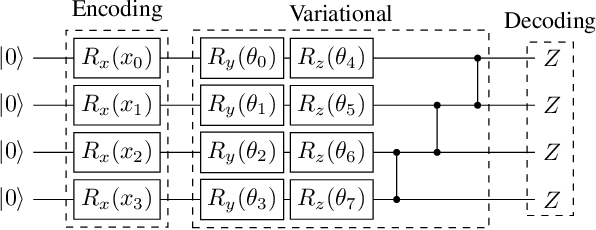
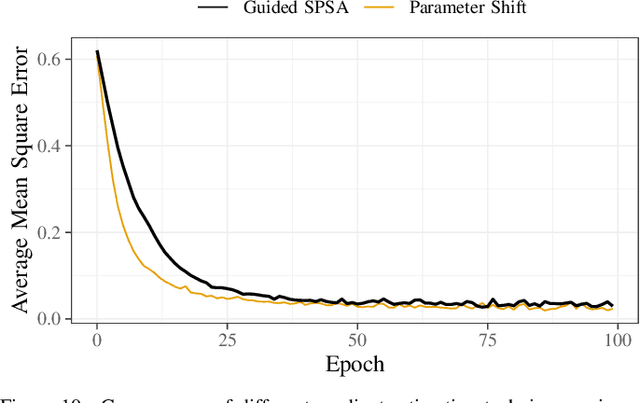
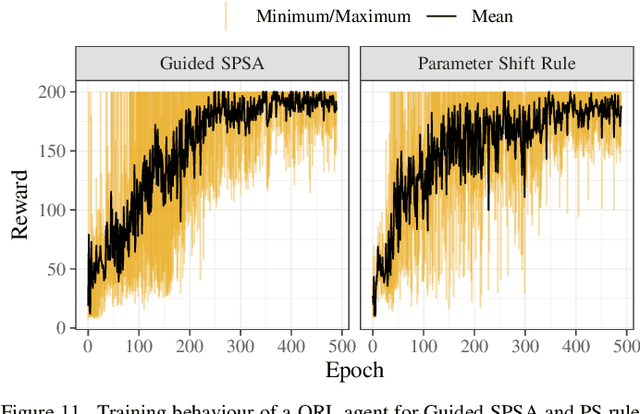

Abstract:The study of variational quantum algorithms (VQCs) has received significant attention from the quantum computing community in recent years. These hybrid algorithms, utilizing both classical and quantum components, are well-suited for noisy intermediate-scale quantum devices. Though estimating exact gradients using the parameter-shift rule to optimize the VQCs is realizable in NISQ devices, they do not scale well for larger problem sizes. The computational complexity, in terms of the number of circuit evaluations required for gradient estimation by the parameter-shift rule, scales linearly with the number of parameters in VQCs. On the other hand, techniques that approximate the gradients of the VQCs, such as the simultaneous perturbation stochastic approximation (SPSA), do not scale with the number of parameters but struggle with instability and often attain suboptimal solutions. In this work, we introduce a novel gradient estimation approach called Guided-SPSA, which meaningfully combines the parameter-shift rule and SPSA-based gradient approximation. The Guided-SPSA results in a 15% to 25% reduction in the number of circuit evaluations required during training for a similar or better optimality of the solution found compared to the parameter-shift rule. The Guided-SPSA outperforms standard SPSA in all scenarios and outperforms the parameter-shift rule in scenarios such as suboptimal initialization of the parameters. We demonstrate numerically the performance of Guided-SPSA on different paradigms of quantum machine learning, such as regression, classification, and reinforcement learning.
Warm-Start Variational Quantum Policy Iteration
Apr 16, 2024Abstract:Reinforcement learning is a powerful framework aiming to determine optimal behavior in highly complex decision-making scenarios. This objective can be achieved using policy iteration, which requires to solve a typically large linear system of equations. We propose the variational quantum policy iteration (VarQPI) algorithm, realizing this step with a NISQ-compatible quantum-enhanced subroutine. Its scalability is supported by an analysis of the structure of generic reinforcement learning environments, laying the foundation for potential quantum advantage with utility-scale quantum computers. Furthermore, we introduce the warm-start initialization variant (WS-VarQPI) that significantly reduces resource overhead. The algorithm solves a large FrozenLake environment with an underlying 256x256-dimensional linear system, indicating its practical robustness.
Comprehensive Library of Variational LSE Solvers
Apr 15, 2024


Abstract:Linear systems of equations can be found in various mathematical domains, as well as in the field of machine learning. By employing noisy intermediate-scale quantum devices, variational solvers promise to accelerate finding solutions for large systems. Although there is a wealth of theoretical research on these algorithms, only fragmentary implementations exist. To fill this gap, we have developed the variational-lse-solver framework, which realizes existing approaches in literature, and introduces several enhancements. The user-friendly interface is designed for researchers that work at the abstraction level of identifying and developing end-to-end applications.
Qiskit-Torch-Module: Fast Prototyping of Quantum Neural Networks
Apr 09, 2024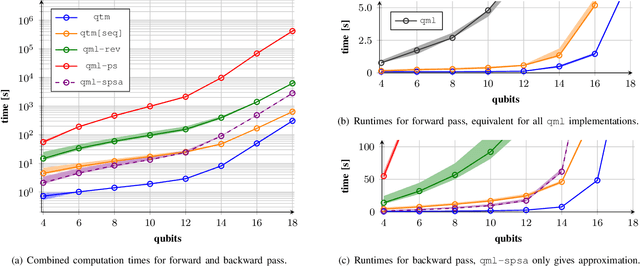
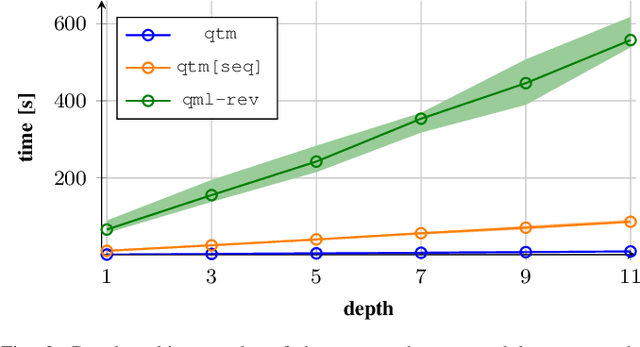
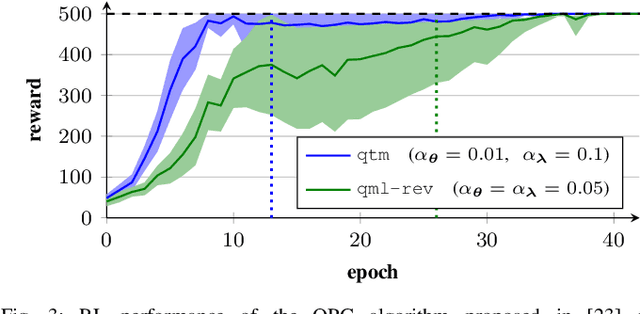
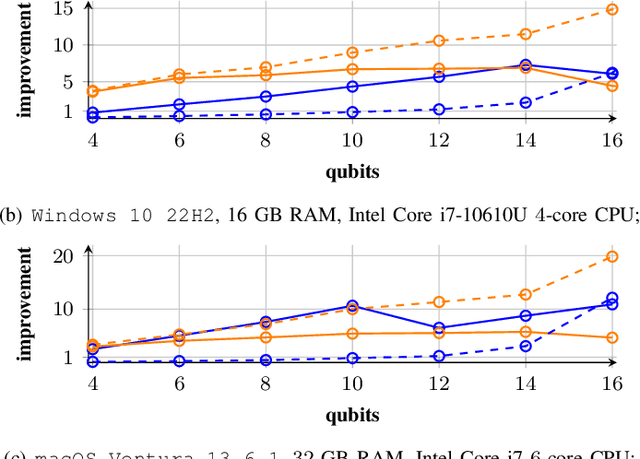
Abstract:Quantum computer simulation software is an integral tool for the research efforts in the quantum computing community. An important aspect is the efficiency of respective frameworks, especially for training variational quantum algorithms. Focusing on the widely used Qiskit software environment, we develop the qiskit-torch-module. It improves runtime performance by two orders of magnitude over comparable libraries, while facilitating low-overhead integration with existing codebases. Moreover, the framework provides advanced tools for integrating quantum neural networks with PyTorch. The pipeline is tailored for single-machine compute systems, which constitute a widely employed setup in day-to-day research efforts.
C-MCTS: Safe Planning with Monte Carlo Tree Search
May 25, 2023Abstract:Many real-world decision-making tasks, such as safety-critical scenarios, cannot be fully described in a single-objective setting using the Markov Decision Process (MDP) framework, as they include hard constraints. These can instead be modeled with additional cost functions within the Constrained Markov Decision Process (CMDP) framework. Even though CMDPs have been extensively studied in the Reinforcement Learning literature, little attention has been given to sampling-based planning algorithms such as MCTS for solving them. Previous approaches use Monte Carlo cost estimates to avoid constraint violations. However, these suffer from high variance which results in conservative performance with respect to costs. We propose Constrained MCTS (C-MCTS), an algorithm that estimates cost using a safety critic. The safety critic training is based on Temporal Difference learning in an offline phase prior to agent deployment. This critic limits the exploration of the search tree and removes unsafe trajectories within MCTS during deployment. C-MCTS satisfies cost constraints but operates closer to the constraint boundary, achieving higher rewards compared to previous work. As a nice byproduct, the planner is more efficient requiring fewer planning steps. Most importantly, we show that under model mismatch between the planner and the real world, our approach is less susceptible to cost violations than previous work.
Batch Quantum Reinforcement Learning
Apr 27, 2023



Abstract:Training DRL agents is often a time-consuming process as a large number of samples and environment interactions is required. This effect is even amplified in the case of Batch RL, where the agent is trained without environment interactions solely based on a set of previously collected data. Novel approaches based on quantum computing suggest an advantage compared to classical approaches in terms of sample efficiency. To investigate this advantage, we propose a batch RL algorithm leveraging VQC as function approximators in the discrete BCQ algorithm. Additionally, we present a novel data re-uploading scheme based on cyclically shifting the input variables' order in the data encoding layers. We show the efficiency of our algorithm on the OpenAI CartPole environment and compare its performance to classical neural network-based discrete BCQ.
An Empirical Comparison of Optimizers for Quantum Machine Learning with SPSA-based Gradients
Apr 27, 2023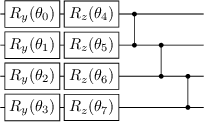
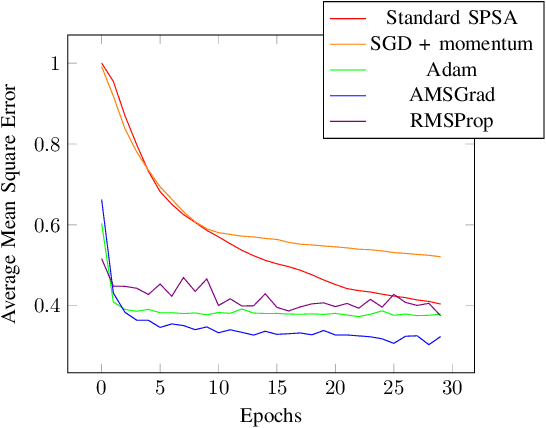
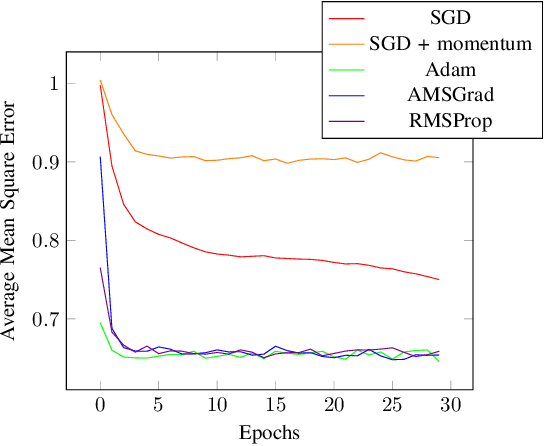

Abstract:VQA have attracted a lot of attention from the quantum computing community for the last few years. Their hybrid quantum-classical nature with relatively shallow quantum circuits makes them a promising platform for demonstrating the capabilities of NISQ devices. Although the classical machine learning community focuses on gradient-based parameter optimization, finding near-exact gradients for VQC with the parameter-shift rule introduces a large sampling overhead. Therefore, gradient-free optimizers have gained popularity in quantum machine learning circles. Among the most promising candidates is the SPSA algorithm, due to its low computational cost and inherent noise resilience. We introduce a novel approach that uses the approximated gradient from SPSA in combination with state-of-the-art gradient-based classical optimizers. We demonstrate numerically that this outperforms both standard SPSA and the parameter-shift rule in terms of convergence rate and absolute error in simple regression tasks. The improvement of our novel approach over SPSA with stochastic gradient decent is even amplified when shot- and hardware-noise are taken into account. We also demonstrate that error mitigation does not significantly affect our results.
Efficient Beam Search for Initial Access Using Collaborative Filtering
Sep 14, 2022



Abstract:Beamforming-capable antenna arrays overcome the high free-space path loss at higher carrier frequencies. However, the beams must be properly aligned to ensure that the highest power is radiated towards (and received by) the user equipment (UE). While there are methods that improve upon an exhaustive search for optimal beams by some form of hierarchical search, they can be prone to return only locally optimal solutions with small beam gains. Other approaches address this problem by exploiting contextual information, e.g., the position of the UE or information from neighboring base stations (BS), but the burden of computing and communicating this additional information can be high. Methods based on machine learning so far suffer from the accompanying training, performance monitoring and deployment complexity that hinders their application at scale. This paper proposes a novel method for solving the initial beam-discovery problem. It is scalable, and easy to tune and to implement. Our algorithm is based on a recommender system that associates groups (i.e., UEs) and preferences (i.e., beams from a codebook) based on a training data set. Whenever a new UE needs to be served our algorithm returns the best beams in this user cluster. Our simulation results demonstrate the efficiency and robustness of our approach, not only in single BS setups but also in setups that require a coordination among several BSs. Our method consistently outperforms standard baseline algorithms in the given task.
Driver Dojo: A Benchmark for Generalizable Reinforcement Learning for Autonomous Driving
Jul 23, 2022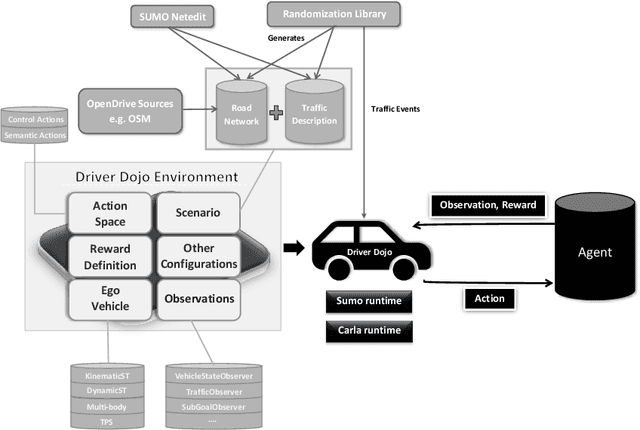
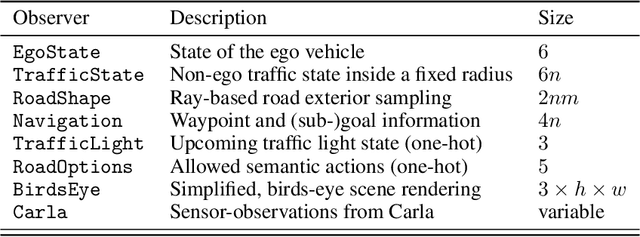
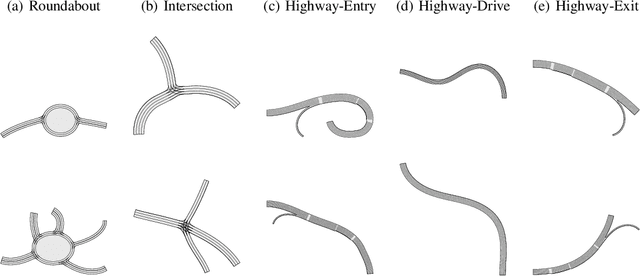
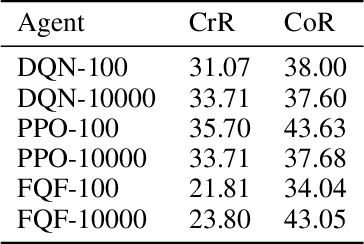
Abstract:Reinforcement learning (RL) has shown to reach super human-level performance across a wide range of tasks. However, unlike supervised machine learning, learning strategies that generalize well to a wide range of situations remains one of the most challenging problems for real-world RL. Autonomous driving (AD) provides a multi-faceted experimental field, as it is necessary to learn the correct behavior over many variations of road layouts and large distributions of possible traffic situations, including individual driver personalities and hard-to-predict traffic events. In this paper we propose a challenging benchmark for generalizable RL for AD based on a configurable, flexible, and performant code base. Our benchmark uses a catalog of randomized scenario generators, including multiple mechanisms for road layout and traffic variations, different numerical and visual observation types, distinct action spaces, diverse vehicle models, and allows for use under static scenario definitions. In addition to purely algorithmic insights, our application-oriented benchmark also enables a better understanding of the impact of design decisions such as action and observation space on the generalizability of policies. Our benchmark aims to encourage researchers to propose solutions that are able to successfully generalize across scenarios, a task in which current RL methods fail. The code for the benchmark is available at https://github.com/seawee1/driver-dojo.
 Add to Chrome
Add to Chrome Add to Firefox
Add to Firefox Add to Edge
Add to Edge